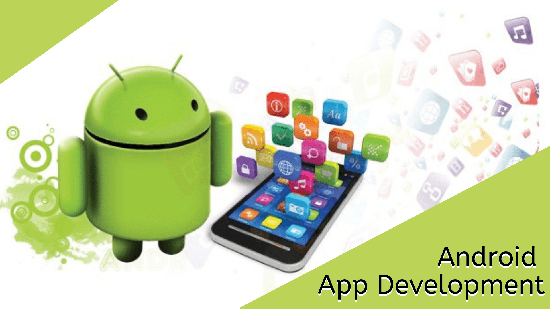You can use an integrated development environment (IDE) to write your code and access the Android SDK tools. IDEs also help you manage external libraries and organize your code to make it easier to debug and release new versions of the app.


Android software development kit (SDK)
The Android software development kit (often referred to as the SDK) is a set of libraries and tools that are required to create and operate Android applications. It’s a free and open-source software package released every time Google releases a new Android operating system (OS) version.
SDKs enable you to write apps that work on different platforms or with specific services, such as payment systems, messaging, or analytics. If you use a mobile software development kit (SDK), you will be able to speed up the process of developing and testing your app, which will, in the long run, save you both time and money.
An SDK includes documentation, code samples and APIs, programming tools, and debuggers. It also provides a smooth flow from developing to testing and packaging your application.
Using an SDK to create an Android app is essential because it allows you to integrate vital app functions such as payment, location, messaging, and analytics more quickly and reliably than would be possible without the SDK. The SDK also enables you to scale your applications easily so that they can grow with your business needs.
In order to use the SDK,
You need first to download and install it on your computer. This is done through an installation program that’s included in the SDK.
Once you have the SDK installed, you can start building your applications in an Eclipse IDE. After you’ve configured an Eclipse plug-in for the SDK, you can choose a build target consisting of the platform (Android OS version number) and the API level you want your application to be built with.
After selecting your build target, you can begin writing your Android project. When you click Next, you’ll see a dialog box that asks you to define a build target name and an initial value for the uses-sdk attribute in your application’s manifest.
Your manifest contains a list of your application’s attributes, such as its identifier and platform. This information will be used to compile your project when it’s time to deploy your app to an Android device or an Android AVD.
An Android AVD consists of a QEMU-based emulator that emulates the hardware of an Android device, plus a set of Android system images that contain the Android software that you’re going to write to run on the simulated devices. You’ll need to configure the AVD using the SDK and the AVD Manager, which sets parameters like screen dimensions and storage devices.
Android application programming interface (API)
The Android application programming interface (API) is a set of tools and protocols that allows one software program to communicate with another. It is used to create Android apps, which are used to run on mobile devices.
APIs are a fundamental part of Android app development and allow developers to connect apps to different services, such as Google Maps. Developers using APIs can make their apps more interactive and useful.
For example,
A mobile app can integrate with a social media service to provide real-time updates about events and news. This feature makes the app more accessible to its users and adds an extra layer of security.
However, APIs can be tricky to implement. If you want to design an app that is popular with users, you need to understand how these things work thoroughly.
You will learn how to consume REST APIs and establish an HTTP response cache for your application by following the instructions in this guide. This can reduce your app’s bandwidth consumption and improve performance.
You’ll also learn how to use the HttpURLConnection class to interact with an API. This is a handy class for Android developers because it offers convenient methods that can simplify your code.
The Android SDK uses the HttpURLConnection library to handle REST APIs. The library provides several convenient methods for consuming an API, faking an IP address, creating an HTTP response cache, and executing an HTTP request.
There are many other libraries for Android that you can use to develop your app. Some of these libraries are bundled in the Android SDK, and some are not.
If you are developing an Android app that has a lot of user input, you should implement click-and-touch event listeners to handle them properly. These can be added to UI components like buttons, text fields, and menus.
Besides, it would help if you also implemented a custom button style to customize your buttons for different screen sizes and orientations. This can help your app stand out from the crowd and ensure that users don’t have to adjust their screen settings to get your app to work correctly.
Android user interface (UI)
The Android user interface (UI) is the set of tools that users use to interact with an app. It is mainly a touchscreen user interface but can also include other technologies, such as haptic feedback and internal hardware, to detect the user’s motion or the orientation of the screen.
UI design is one of the most important aspects of Android app development. It should be intuitive, easy on the eyes, and provide logical next steps for users.
In Android app development, the UI is composed of a series of graphical elements known as views. Each view responds to specific user inputs and controls different parts of an app.
A View class is the primary UI component and is culpable for event handling and drawing. It also provides a base for other UI components called views and view groups.
There are many types of views, such as TextView and ImageView. They are arranged in various ways to create layouts that display a variety of content.
Each UI element is associated with a run-time object that contains the XML declaration of its corresponding Java class. This object is created when the UI is loaded, and each UI element is then instantiated.
Depending on the size of a UI element, these run-time objects can vary in number and complexity. Some UI elements are simple widgets, such as the bottom app bar or a navigation destination; others may be large and complicated, such as a pinning toolbar.
In addition,
UI elements often depend on the underlying data that they consume. For example, an app might need to store or display a user’s bookmarks and preferences, which requires a complex data structure.
The UI logic that is required to generate this data and process it is typically best delegated to another class so that the UI can focus on its sole responsibility. This helps to favor testability and separation of concerns, as well as avoid the complexities that can arise when interactions and their logic become tightly coupled in the UI itself.
Creating a UI can be daunting, especially in a complex application such as an Android app. However, Concept Draw DIAGRAM, especially extended with Android User Interface Solution from the Software Development Area, makes this process faster and easier by providing a wide range of pre-designed sample templates that can be used as the base for your own custom UI.
Android hardware
Android is an operating system that runs on mobile devices such as phones and tablets. It is a free platform created by Google that allows developers to create applications for these devices. Because the program is open source, anybody can download and edit its source code, and a wide variety of applications can be developed using it.
The Android platform consists of a hardware abstraction layer (HAL), a Java API framework, and a Linux kernel that provides low-level functionality. The hardware abstraction layer handles the interface between the higher-level Java API framework and the device hardware, allowing Android to take advantage of the device’s built-in capabilities, such as its camera or GPS sensor.
For app development, developers use the Android SDK, which includes prewritten code and a debugger. It also includes a device emulator, documentation, sample codes, and tutorials.
Developers can create Android applications using any programming language that supports Java virtual machine (JVM) code. Some of the most popular languages include Kotlin, C/C++, and JavaScript. Some of these languages are cross-platform in order for them to be utilized in the creation of applications for both Android and iOS-based devices.
Developing Android apps involves designing the user interface and implementing various features that allow users to interact with their devices.
These features are usually based on the device’s hardware components, including sensors and actuators. Some of these hardware features, such as the camera and GPS sensor, are standard on all devices.
Some of these devices have other hardware features, such as accelerometers or gyroscopes, that can detect motion and rotation. These devices may also be able to provide haptic feedback through vibrations when the device is moved or touched.
For example,
the Jetpack Compose toolkit is a Kotlin-based framework that allows developers to build high-quality user interfaces for Android by combining a set of libraries with Android Studio. It accelerates development and reduces boilerplate code.
Many developers use Android libraries, which are snippets of prewritten code that automate a developer’s task and eliminate the need to write the entire program from scratch. Some of these libraries are available for free, but others require a subscription.
What are the Benefits of Android app development services?
Android is one of the world’s most popular and widely used mobile operating systems. It has a market share of nearly 85%.
The Android platform offers many benefits for businesses and developers. Some of these include a quick development cycle, global presence, multiple sales channels, and more.
Quick Development Cycle
The Android app development process is divided into multiple stages. Each phase includes activities like establishing a development environment, different coding parts of the code, and testing the app before releasing it.
UI design is also a part of the mobile app development process. This involves creating user interface layouts, graphics, and colors. It is a critical stage in the process because it helps ensure that the app is user-friendly and easy to use.
A good developer will take the time to develop a comprehensive and accurate UI for your application. This will help you avoid any major UI issues later in the lifecycle of your application.
Another important part of the app development cycle is back-end development. This is part of the process that bridges the front end of your application to the server and data storage. This also involves APIs and business logic.
Back-end engineering also includes Database and server-side object creation, versioning, data integration, and user management. It is a crucial step in the development of an app because it allows for seamless functionality across different platforms and devices.
While developing an app, it is always a good idea to get feedback from beta testers. This will help you identify bugs and make improvements to your app before releasing it to the public.
Final Phase
The final phase of the Android app development process is publishing to an app store such as Google Play Store or Apple iTunes App Store. This is a crucial step because it ensures that your app follows the guidelines of both stores.
The app development process can be long, but it is worth the effort because it will ensure that you have a quality product. The process is iterative, and each milestone in the cycle will ensure that all errors or bugs are addressed before moving on to the next one.
Global Presence
Almost 70% of the world’s mobile users use Android devices. This statistic makes it essential to have an Android app for business purposes.
A good Android app development company can give your business a leg up over the competition. These companies will help you get a mobile app that can provide your business with the functionality it needs and the look and feel that customers will want.
They’ll also help you get your app on the Google Play Store to reach more potential customers than you ever hoped. The company should also have a solid reputation for high-quality work so that you can rest easy knowing you’re getting the best possible product.
The Best advantage of Android app development is that it is a platform compatible with a wide variety of devices, including smartphones, tablets, wearables, TVs, IoT, AR, and VR. This means that you can offer your customers the latest experience no matter where they are in the world.
Finally, the best Android app development company will have a team of experts that are well-versed in the latest and greatest in mobile technologies. This can include artificial intelligence, machine learning, and other cutting-edge tools that will help your business get ahead of the competition.
The top-notch mobile application company, SoluLab, offers a range of high-end apps for both Android and iOS platforms. Their team of expert app developers can build you a mobile app that is designed to meet your exact requirements. They can develop your app in a slick and scalable way so that it’s easy to manage and maintain. They also have an impressive track record of retaining the majority of their clients for years to come.
Multiple Sales Channels
As an open-source platform, Android offers plenty of customization options and gives you the freedom to distribute your app in any way you see fit. For example, you can publish it in an app marketplace, serve it from a website, or even email it directly to your users.
A recent study reveals that Android powers more than 80% of mobile devices. It is also the world’s leading app market, with more than 800 million active Android users worldwide.
It’s not surprising that many businesses rely on Android app development to enhance their customer experience and boost business growth.
A well-designed and marketed Android app can help you stand out from the competition by improving user engagement, increasing brand awareness, and even enhancing employee productivity. Whether you’re looking to launch a new application or improve an existing one, our team of skilled app developers will take care of all the basic details so you can focus on your core competencies.
Top mobile application development company come with an impressive list of benefits, including a streamlined process, high-quality code, and superior ROI. From quick and efficient project management to the latest communication technologies, our experts are ready to bring your idea to life. The next time you are in the market for a top-of-the-line Android app, remember to look at our extensive portfolio of successful projects.
Cost-Effectiveness
The cost of Android app development services varies greatly depending on several factors. For instance, the number of developers needed for a project can affect the total price. It can also be impacted by the country in which the developer lives and their expertise.
To save on costs, you can hire an in-house development team instead of external developers. However, this comes with its own set of challenges. For example, it can take a long time to train the in-house team. And there may be delays in getting your app live on the App Store or Play Store.
For an effective solution, consider hiring a dedicated Android app development agency that specializes in the specific mobile platform. They’ll have a wide range of experience and skills and proven pre-launch and post-sales support.
Another factor that can affect the app development cost is the use of smartphone hardware features. Such as GPS navigation, NFC technology, motion co-processor, and Augment Reality tech. This can add a lot of complexity to the app, which could increase its development cost.
In addition, the number of screens required in the app can be an important factor that will impact the development cost. For example, a simple app that has only a few features and no UI design will not require as many screens as an advanced application with a layered UI.
If you need help determining the app development cost, use an intuitive calculator that estimates the final cost of your project. It’s designed in a shopping cart style and calculates the price based on all of your choices. It’s a great way to get an idea of the overall cost before choosing a company to work with.
Scalability
Scalability is the ability of an app to handle a growing number of users or requests. It ensures that the application can function efficiently and without a significant delay when there are more users.
When it comes to mobile apps, scalability is especially important for those that rely on user interaction. This requires the app to respond to many requests quickly while minimizing downtime and ensuring a positive user experience.
It is vital to choose the right system architecture for your scalability needs. This will determine how your app scales as your business grows and how fast it can react to changing demands.
A highly scalable app can handle more user requests and a larger database without slowing down or causing data delays. This will help you keep up with user demand and improve your ROI.
During the app development process. It is vital to do performance testing on a regular basis in order to identify bottlenecks and other scalability issues that can impede your app’s performance. This will help you avoid costly glitches and updates in the future.
Another important aspect of scalability is code quality. Your app’s code should be clear and readable so that it is easy to update and meet changing requirements. It should also be maintainable and less complex to rewrite. So you can easily add new features or make other changes.
A scalable Android app will be able to scale up easily when your business grows. Making it easier for you to reach more customers and increase your revenue. It will provide your users with an exceptional experience and allow them to use the app for longer periods of time.
















